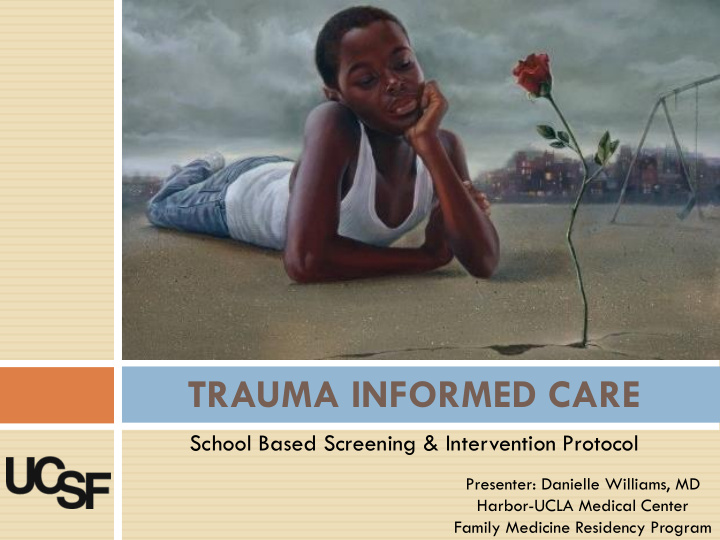



TRAUMA INFORMED CARE School Based Screening & Intervention Protocol Presenter: Danielle Williams, MD Harbor-UCLA Medical Center Family Medicine Residency Program
Project Purpose To implement Trauma Informed Care practices within the Vallejo Full Service Community Schools through the appropriate screening, assessment and treatment of youth exposed to trauma. To assist the Vallejo City Unified School District (VCUSD) in the improvement of student achievement and decline of dropout rates. To Increase caregiver’s involvement and education in their child’s mental health.
Community Site Vallejo is the largest city in Solano County, California and it is the tenth most populous city in the San Francisco Bay Area with a population of 115,942 people. According to the 2010 Census, 16% of Vallejo’s population lives below the poverty line with African- Americans and Latinos accounting for 22.1% and 22.6% of the population, respectively. Based on data and crime statistics from the FBI and the U.S. Justice Department, the violent crime rate in Vallejo is 7.45 per 1000 residents compared to 4.23 per 1000 residents for the entire state of California.
What is Trauma Informed Care (TIC)? A program, organization, or system that is trauma-informed realizes the widespread impact of trauma and: Understands potential paths for healing; 1. Recognizes the signs and symptoms of 2. trauma in staff, clients, and others involved with the system; and Responds by fully integrating knowledge 3. about trauma into policies, procedures, practices, and settings. http://www.samhsa.gov/traumajustice/traumadefinition/approach.aspx
Project Methodology Step 1: At risk youth identified (by internal school referral) for symptom screening (9-item screening tool) Step 2: Youth who screen positive for symptoms of trauma are triaged to receive diagnostic screener (TESI proposed as screening tool – this step requires health professional trained in TIC) Step 3: Intervention – Four areas in which the school can provide or link youth and families with support, resources and treatment for trauma. (Home & Family Based Interventions, School-Based Interventions, Community Resources, Family Education)
! ! ! ! ! ! ! ! ! ! ! ! ! ! ! !
Home & Family Based Interventions Learn about the common reactions that children have to traumatic events. Assure your child of his or her safety at home and at school. Talk with him or her about what you’ve done to make him or her safe at home and what the school is doing to keep students safe. Reassure your child that he or she is not responsible. Children may blame themselves for events, even those completely out of their control. Allow your child to express his or her fears and fantasies verbally or through play. That is a normal part of the recovery process. Maintain regular home and school routines to support the process of recovery, but make sure your child continues going to school and stays in school. Be patient. There is no correct timetable for healing. Some children will recover quickly. Other children recover more slowly. Try not to push him or her to “just get over it,” and let him or her know that he or she should not feel guilty or bad about any of his or her feelings. Child Trauma Toolkit for Educators, October 2008, www.NCTSN.org
School-Based Interventions Cognitive-Behavioral Intervention for Trauma in Schools (CBITS) is a skills-based, child group intervention. The program consists of ten group sessions (6-8 children/group) of approximately an hour in length, usually conducted once a week in a school setting. In a randomized controlled study, children in the CBITS intervention group had significantly greater improvement in PTSD and depressive symptoms compared to those on the waitlist at a three-month follow-up. Multimodality Trauma Treatment (MMTT) is a skills-oriented, cognitive-behavioral treatment approach designed as a peer-mediating group intervention in schools. There are fourteen group sessions with 6-8 members per group delivered during one class period a week. Experimental control across time and setting in a small sample (in two elementary and two junior high schools) demonstrated robust beneficial effects of treatment for reducing PTSD, depression, anxiety, and anger using an 18 session protocol. UCLA Trauma and Grief Component Therapy (TGCT) is a short-term, manualized program for traumatized and/or bereaved youth (11 – 18 years old) for use in clinical or school settings. Both published open trials and a randomized controlled trial indicate significant reductions in PTSD, depression and complicated grief reactions, and improvements in school behavior with TGCT.
Family Education The National Child Traumatic Stress Network, www.NCTSNet.org The New York Child Study Center, www.aboutourkids.org The National Center for Children Exposed to Violence at the Yale Child Study Center, www.nccev.org The National Center for PTSD, www.ncptsd.org The Office for Victims of Crime — US Dept. of Justice, www.ojp.usdoj.gov/ovc The International Society for Traumatic Stress Studies, www.istss.org National Center for Victims of Crime, www.ncvc.org
Conclusion Socioeconomically disadvantaged children have the greatest difficulty accessing mental health services. Traumatized individuals are also less likely than their non-traumatized counterparts to seek health services. Thus, the most vulnerable youth are those least likely to receive traditional, clinic-based mental health care. Schools can serve an important role in addressing unmet mental health needs following trauma, if children receive high-quality mental health services for trauma in schools.
Recommend
More recommend